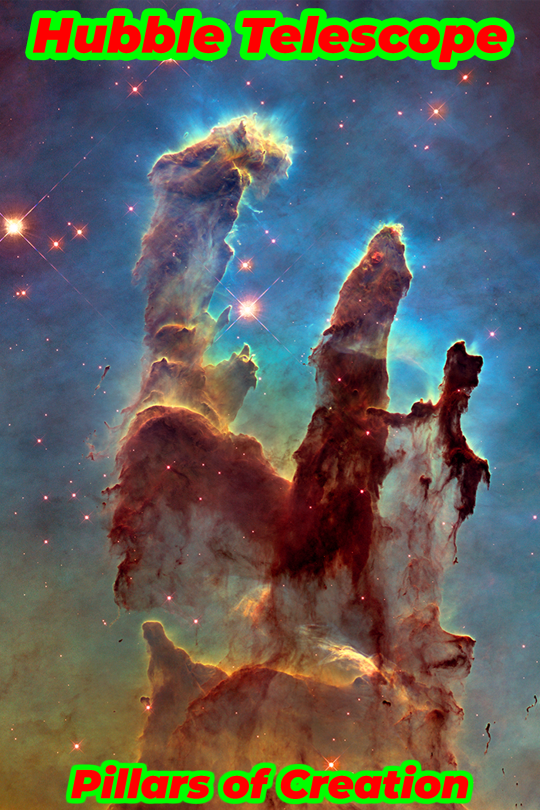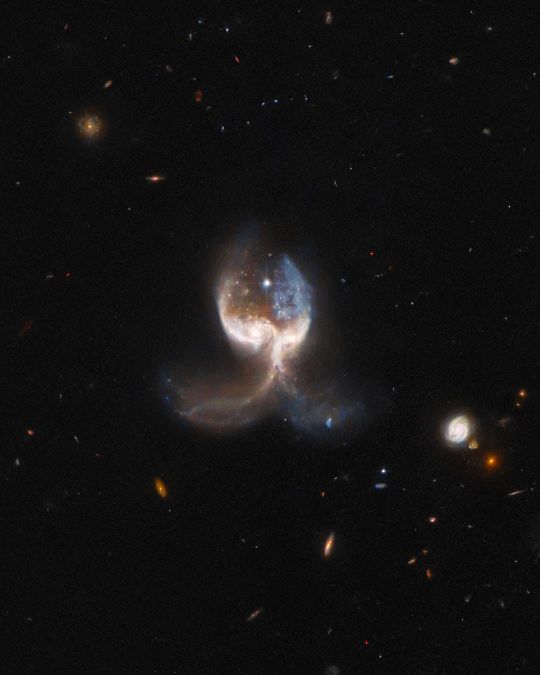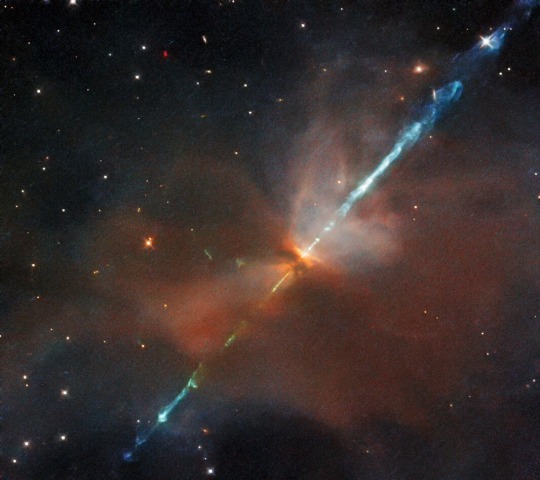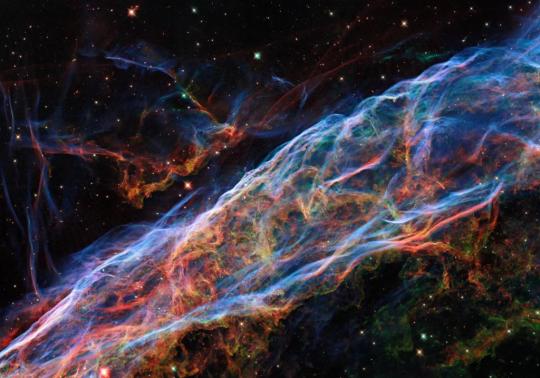#hubblefriday
Text

It's December 30th. On this day in 1924, 🗽 American astronomer Edwin Hubble (20 Nov 1889 – 28 Sep 1953) announced the object in the sky then known as the "Andromeda Nebula" was a 🌌 galaxy. This revelation instantly doubled the number of galaxies and stars in the known universe and hinted at a vastly greater number, for until then every star that could be seen in the sky, either by the naked eye or by telescope, had been assumed to belong to our own Milky Way Galaxy. An entirely new scientific field was born – cosmology.
Hubble based his announcement upon his ingenious analysis of a Cepheid variable ⭐ star in the Andromeda Nebula. In 1912, 🗽 American astronomer Henrietta Leavitt had invented a formula for calculating the distance from our Solar System to Cepheids. Using Leavitt's formula, Hubble determined that a Cepheid inside the Andromeda Nebula was much further away than anyone had thought and that, therefore, the nebula was not a gaseous cloud inside our own galaxy, but was in fact a galaxy of stars just like the Milky Way… and very far away.
Later, in 1929, Hubble provided observational proof of 🇫🇷 French astronomer Georges Lemaître's "Expanding Universe" hypothesis. The resultant Hubble-Lemaître Law states that galaxies are receding from Earth at speeds directly proportional to their distances, like spots on an inflating 🎈 balloon. Hubble calculated the rate of this expansion, which is now known as the Hubble constant, to be 170 kilometers per second per light year of distance. These discoveries led Hubble, Lemaître, and most other astronomers of that era to the obvious conclusion that an expanding universe, much like the result of an 💥 explosion, must have once existed in a tight unexploded state. Lemaître coined this hypothesis the "Primeval Atom Hypothesis," which of course is now known all over the planet, thanks to 📺 Dr. Sheldon Cooper and friends, as the "Big Bang Theory."
NASA paid tribute to Hubble's great and many contributions to astronomy and cosmology by naming its first "Great Observatories" 🔭 space telescope after him. This workhorse eye in the sky was launched into low-Earth orbit in 1990. It is one of the largest and most versatile research tools ever devised by Homo sapiens and has been responsible for countless scientific, engineering, and technological breakthroughs. Five days ago, on 25 Dec 2021, NASA launched Hubble's de facto successor, the James Webb Space Telescope into outer space. ☮️ R.I.P., Edwin… Jamiese of Pixoplanet
#hubble#edwinhubble#hubblebubble#hubbleandduke#hubblespacetelescope#hubbletelescope#bubble#hubbleclassic#nasahubble#prilaga#hubblethesquid#spothubble#hubblescoop#hubblehangout#shubble#hubblestudio#mildredhubble#hubblefriday#Jamiese#Pixoplanet
3 notes
·
View notes
Photo

🔵 Dual nature 🔴 These #HubbleFriday views show different aspects of the expanding shell of gas and dust surrounding the star AG Carinae. This nebula is about five light-years wide and 10,000 years old! Learn more and try our interactive image slider: go.nasa.gov/39bMMua #nebula #nasa #star #stardeath #hubble #hubblespacetelescope #wow https://www.instagram.com/p/CUCtcsIr5d7/?utm_medium=tumblr
0 notes
Photo

💥 A cataclysmic cosmic collision takes center stage! In this #HubbleFriday image, two galaxies are in the final stages of merging. This interacting galaxy pair, IC 1623, is roughly 275 million light-years away. Discover more: https://t.co/Kt84XhrGai https://t.co/aBhFz2PGhM https://www.instagram.com/p/CQi6KJkhYBO/?utm_medium=tumblr
0 notes
Photo

The spiral galaxy NGC 5037 is 150 million light-years away, but Hubble’s powerful vision lets us see delicate structures of gas and dust in this #HubbleFriday image. NGC 5037 is located in the constellation Virgo. Read more at the link in our bio! Image credits: ESA/Hubble & NASA, D. Rosario; Acknowledgment: L. Shatz #NASA #Hubble #Friday #galaxy #stars #space #science #universe #astronomy #telescope https://www.instagram.com/p/CPa2uiMj1UZ/?utm_medium=tumblr
0 notes
Photo

#HubbleFriday The twisting patterns created by the spiral arms of the galaxy NGC 2835 create the illusion of an eye. This is a fitting description, since it’s located near the head of the constellation Hydra, the water snake. 🐍 In the galaxy’s outer arms, the bright blue regions indicate recent or ongoing star formation. At the galaxy's center is a black hole with a mass millions of times that of our Sun! Credits: ESA/Hubble & NASA, J. Lee, and the PHANGS-HST Team; Acknowledgment: Judy Schmidt (Geckzilla) #NASA #Hubble #Friday #science #space #astronomy #telescope #cosmos #universe #snake Credits from @nasahubble https://t.co/ttkPaWvXLd #messier #astronomyindia #astronomia #stargazingindia #astronomy #astronomer #esa #NASA #Hubble #telescope #astrophotography #Stargazing #stargazingindiatraveller #astronews #skyphotography #skymap #astrophysics #ISRO #youresa #nightphotography #starrynight (at StarGazing India) https://www.instagram.com/p/CFSLMWJj-Tj/?igshid=4xf54ms28qi8
#hubblefriday#nasa#hubble#friday#science#space#astronomy#telescope#cosmos#universe#snake#messier#astronomyindia#astronomia#stargazingindia#astronomer#esa#astrophotography#stargazing#stargazingindiatraveller#astronews#skyphotography#skymap#astrophysics#isro#youresa#nightphotography#starrynight
0 notes
Photo

Photo of Galaxy NGC7773 taken by the Hubble Telescope 🔭 Very similar to our own Milky Way Galaxy. #NGC7773 #HubbleTelescope #NASA #ISS 🔭📷Photo courtesy of @nasa #Repost @nasa ・・・ Mature and gorgeous, this barred spiral galaxy spotted by our @NASAHubble Space Telescope shows a luminous core that is likely acting like a stellar nursery. 👶 ⭐ Astronomers think that bar structures like the one seen crossing through NGC 7773's core emerge later in the lifetime of a galaxy, as star-forming material makes its way toward the galactic center. Our own Milky Way galaxy is thought to look similar to this. Credit: NASA/@esa/@nasahubble/J. Walsh #NASA #universe #space #galaxy #HubbleFriday https://www.instagram.com/p/ByirILGgXG2/?igshid=1mqg7pnfewd3a
0 notes
Photo

#Repost @nasa • • • • • 🌟Shine bright like a cluster 🌟 @NASAHubble has done it again. This image reveals a globular cluster of stars in the constellation of Sagittarius, 18,000 light-years away from Earth. Don’t forget to shine bright today. #HubbleFriday #NASA #ShineBright https://www.instagram.com/nellywamui/p/BvEL22gH_GD/?utm_source=ig_tumblr_share&igshid=1wyjy1pts7yot
0 notes
Text
It's #hubblefriday and this morning I learned about starburst galaxies that create a phenomenon called 'superwind', which is caused by "a gigantic transfer of gas" [to quote the nasahubble IG account], and now I can't stop thinking about Sulu making fart jokes while Spock tries to block him out and analyze star formation. Uhura pretends not to think it's funny but she totally does. Jim laughcries and Spock won't speak to him for a week. Bones stays away from the bridge for once. Maybe Sulu gets inspired and pranks Chekov with a futuristic whoopee cushion I dunno
12 notes
·
View notes
Photo

#Repost @nasa with @make_repost ・・・ 🌟Shine bright like a cluster 🌟 @NASAHubble has done it again. This image reveals a globular cluster of stars in the constellation of Sagittarius, 18,000 light-years away from Earth. Don’t forget to shine bright today. #HubbleFriday #NASA #ShineBright via Instagram https://ift.tt/2Hueqqz
22 notes
·
View notes
Text

In this week’s #HubbleFriday image, two galaxies are seen merging in the VV-689 system. Unlike chance alignments of galaxies, which only appear to overlap when viewed from our vantage point on Earth, the two galaxies in VV-689 are actually in the midst of a collision. The galactic interaction has left the VV-689 system almost completely symmetrical, giving the impression of a vast set of galactic wings.This image comes from a set of Hubble observations that took a closer look at interesting galaxies from the Galaxy Zoo citizen science project. This crowdsourced program relies on hundreds of thousands of volunteers to classify galaxies and help astronomers wade through a deluge of data from robotic telescopes.Credit: ESA/Hubble & NASA, W. Keel; Acknowledgment: J. Schmidt
1 note
·
View note
Photo

These stars may be young but they're mighty. Sometimes, they expel narrow jets of highly charged

These stars may be young but they're mighty. 💪 Sometimes, they expel narrow jets of highly charged gas at hundreds of miles per second. When these streams of gas collide with surrounding clouds of gas and dust, these energetic collisions create stunning objects like the one pictured, known as a Herbig-Haro object. Herbig-Haro objects can be difficult to observe because their surrounding dust and gas absorb visible light. @NASAHubble Space Telescope’s Wide Field Camera 3 takes images at wavelengths outside a range detected by human eyes. Because of Hubble’s ability to observe at infrared wavelengths – where observations are not as affected by gas and dust – observing rare celestial phenomenon like Herbig-Haro objects is made possible! Credit: @EuropeanSpaceAgency/Hubble & NASA, B. Nisini #NASA #HubbleFriday #Space #Astronomy
Note: All rights belong to their respective owners #Astronomy #HubbleFriday #NASA #Space #livenews, #cablenews, #usnews, #businessnews, #worldnews, #news, #eveningnews, #nightlynews, #breakingnews, #nightlynewsnbc, #nbcnewsnow, #newsnbc, #nbcnewslive, #nbcnewstoday, #newstoday, #newsstation, #stockmarket, #nbcnewslivetoday, #newsnbclive, #nbcnewslivestream, #nbcnewsspecialreport, #newswithshepardsmith, #coroner, #nbclive, #nbc, #abc, #nbcspecialreport, #report, #Iamlatest #latesttrend #latestnews #latestissue #latestart #latestpicture #latestupdate #FoxNews #CNN #SkyNews #AlJazeera #BBC #MSNBC #Euronews #GeoNews #NDTVIndia
0 notes
Photo

Regrann from @nasahubble - Don’t be fooled! The cosmic swirl of stars in this Hubble image may seem tranquil and unassuming, but this spiral galaxy, known as ESO 580-49, actually displays some explosive tendencies. In October of 2011, a cataclysmic burst of high-energy gamma-ray radiation — known as a gamma-ray burst, or GRB — was detected coming from the region of sky containing ESO 580-49. Astronomers believe that the galaxy was the host of the GRB, given that the chance of a coincidental alignment between the two is roughly 1 in 10 million. At a distance of around 185 million light-years from Earth, it was the second-closest gamma-ray burst (GRB) ever detected. Gamma-ray bursts are among the brightest events in the cosmos, occasionally outshining the combined gamma-ray output of the entire observable Universe for a few seconds. The exact cause of the GRB that probably occurred within this galaxy, cataloged as GRB 111005A, remains a mystery. Several events are known to lead to GRBs, but none of these explanations appear to fit the bill in this case. Astronomers have therefore suggested that ESO 580-49 hosted a new type of GRB explosion — one that has not yet been characterized. Credit: NASA/Hubble #NASA #Hubble #space #science #astronomy #universe #telescope #cosmos #gammarayburst #grb #spiralgalaxy #HubbleFriday - #regrann #rp
#space#cosmos#science#regrann#universe#nasa#telescope#spiralgalaxy#astronomy#hubblefriday#grb#gammarayburst#hubble#rp
0 notes
Link
0 notes
Photo

formed from the death of a star about 20 times the size of our sun, the veil nebula proves that surprising astronomical beauty can come from stellar violence. this #hubblefriday image shows a small portion of the nebula, which is 2,100 light-years away.
0 notes
Photo

http://twitter.com/HaroldSurf/status/1021301933724717057 RT @NASAHubble: #HubbleFriday In November 2008, 14-year-old Caroline Moore from New York discovered a supernova in UGC 12682. This made her the youngest person at the time to have discovered a supernova: https://t.co/1dsCfLHbtU https://t.co/BJdmoI1BO6
0 notes
Text
RT @NASAHubble: #HubbleFriday NGC2623 has its unique shape due to a late-stage merger between 2 galaxies 250mil light-years away:… https://t.co/SoDFaihpbB
#HubbleFriday NGC2623 has its unique shape due to a late-stage merger between 2 galaxies 250mil light-years away: https://t.co/WUZEbXPT1P http://pic.twitter.com/gMMXNop6DP
— Hubble (@NASAHubble) October 20, 2017
from Twitter https://twitter.com/highwayrocky
October 21, 2017 at 12:48AM
via IFTTT
0 notes